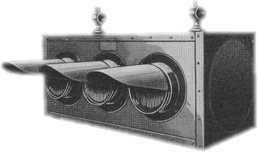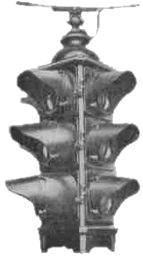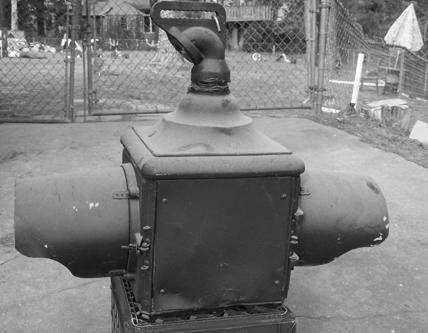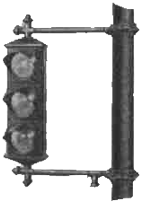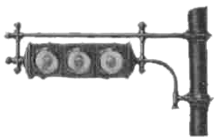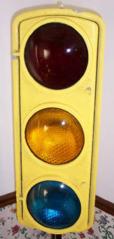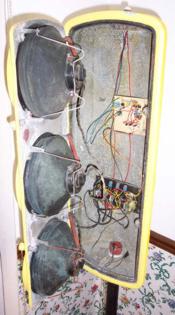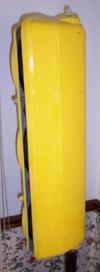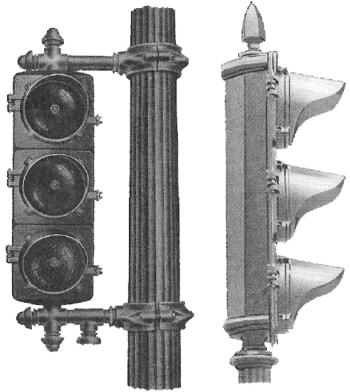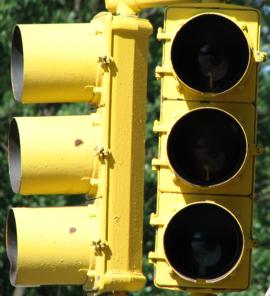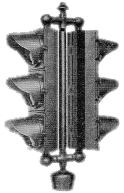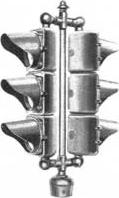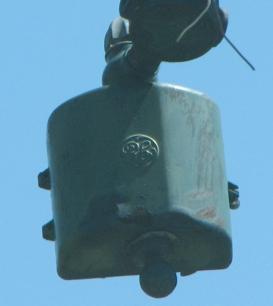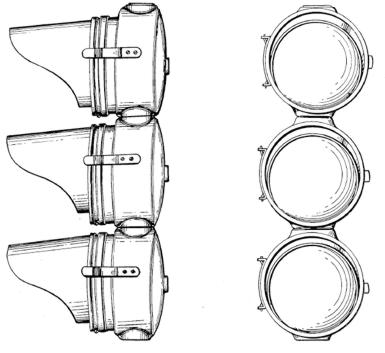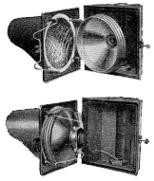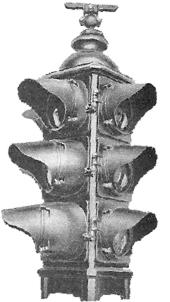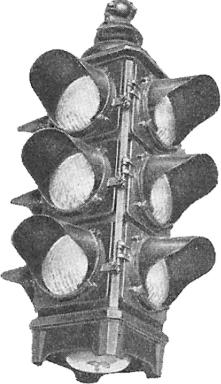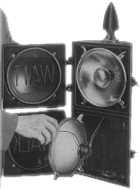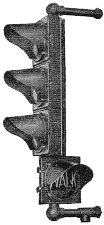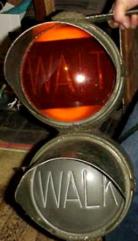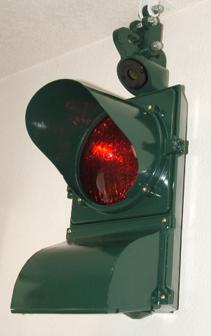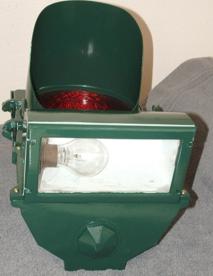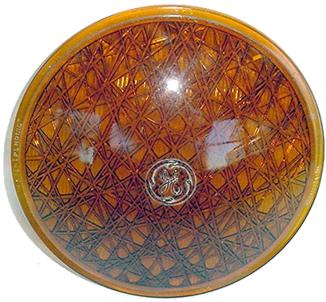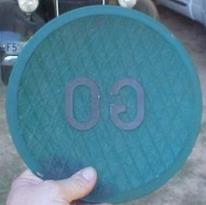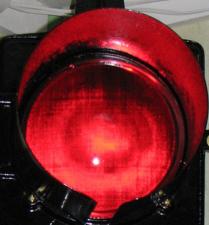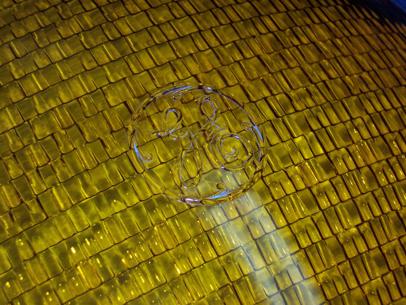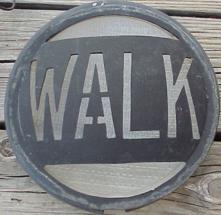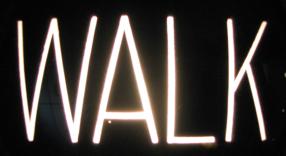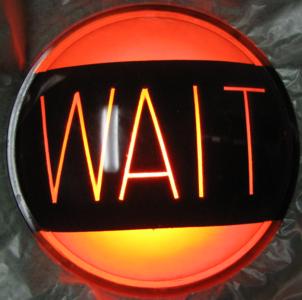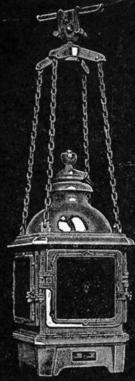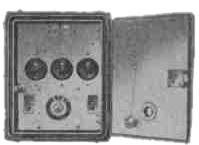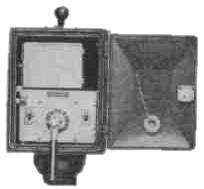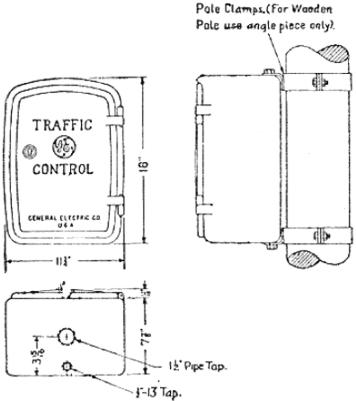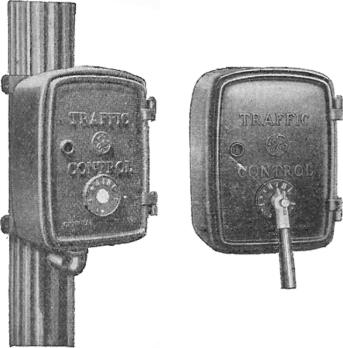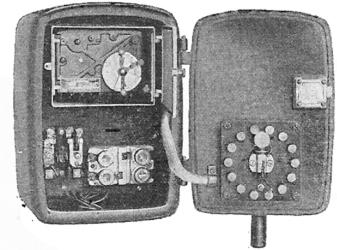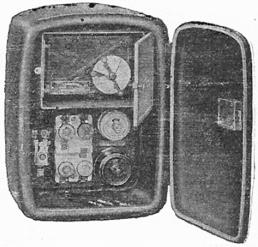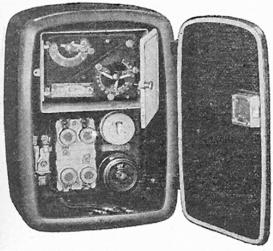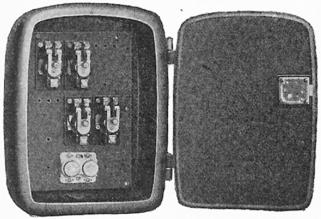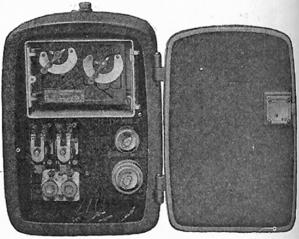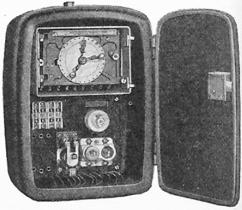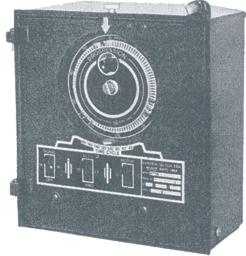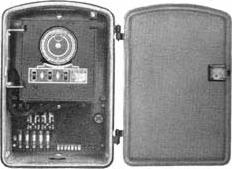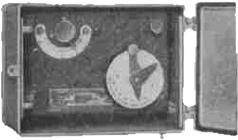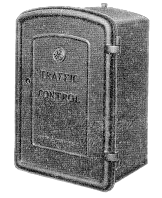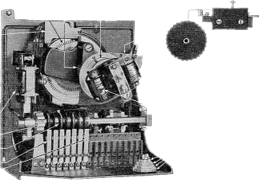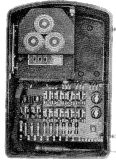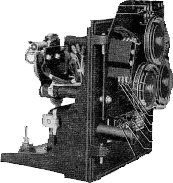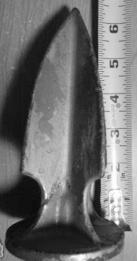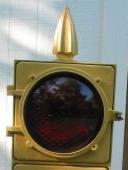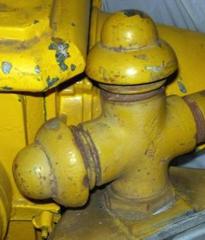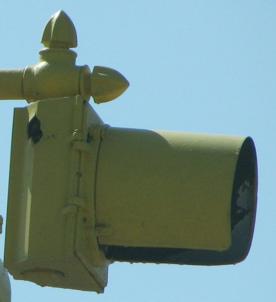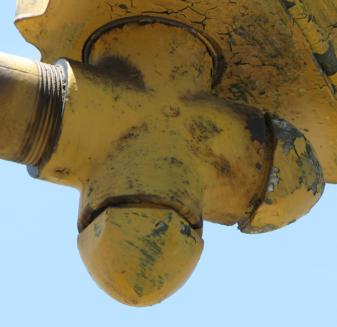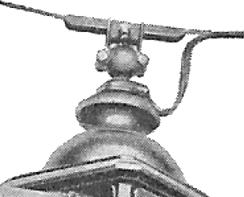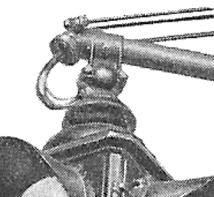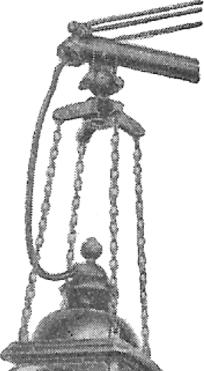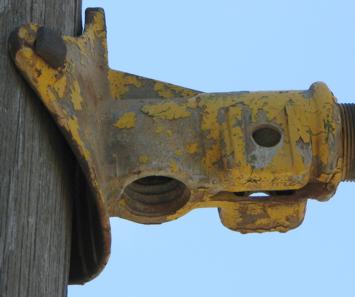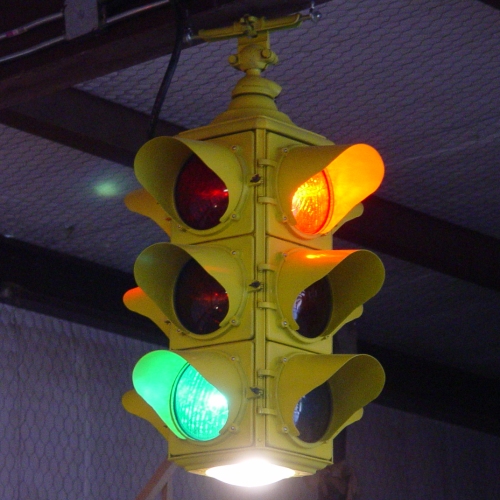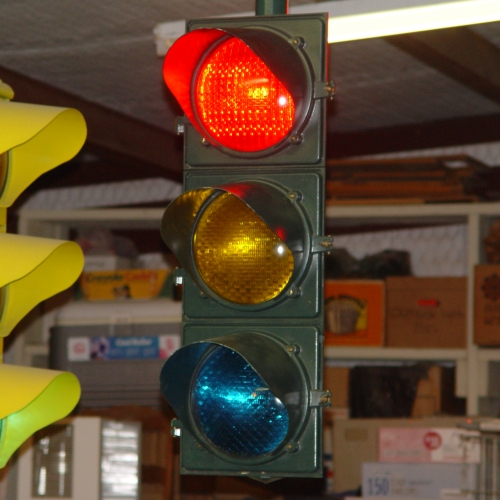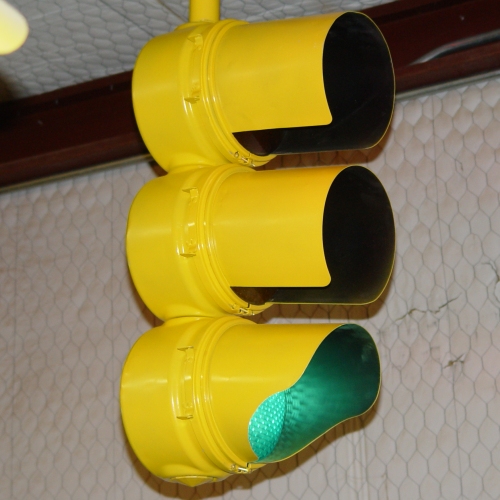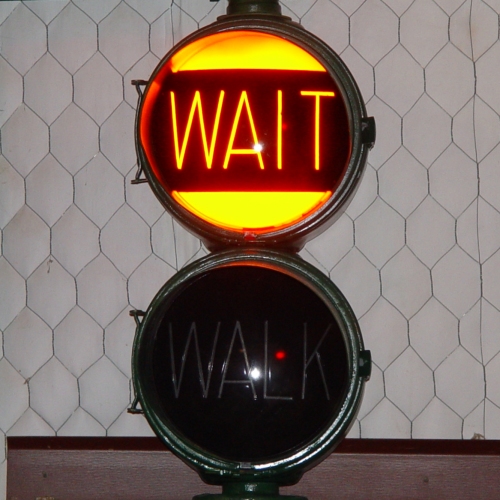General Electric
For the Canadian GE signals see the seperate entry for GE Canada.
(There are other foreign GE pages to link to as well)
Contents
- 1 Summary
- 2 Traffic Signals
- 2.1 Pre Signal Pedestal Signals, Signs, Semaphores
- 2.2 Four Ways
- 2.3 Adjustables
- 2.4 Unique Signal Hardware
- 3 Pedestrian Signals
- 4 Informational Signals and Signs
- 5 Lenses
- 6 Controllers
- 6.1 Form 39 Supervisory Box
- 6.2 Form 41 Curb Control Box
- 6.3 Form 50's and 60's Controllers Overview
- 6.4 Form 50 Synchronous Box
- 6.5 Form 51 Curb Control Box
- 6.6 Form 52 Control Box
- 6.7 Form 53 Control Box
- 6.8 Form 57 Cascade Box
- 6.9 Form 59 Impulse Transmitter Box
- 6.10 Form 60 Impulse Hand and Automatic Reciever Box
- 6.11 Form 62 Impulse Automatic Reciever Box
- 6.12 Novalux Type D Traffic Timer
- 6.13 Type TSM
- 6.14 Type DH Controller
- 6.15 Type DHR Master Controller
- 6.16 Type DHM Triple Dial Controller
- 6.17 Type DJ Condensed Controller
- 6.18 Type V Vehicle Actuated Controller
- 6.19 Novalux Flashing-Beacon Controller
- 6.20 Special Flasher Mechanism
- 7 Hardware
- 8 Restored Examples
- 9 Relevant Patents
- 10 References
Summary
General Electric, USA Division, produced signals in four primary styles under the Novalux name until 1957 when the conventional signal division was sold off to Econolite.
It is a common misconception to refer only to the solid-body adjustable signals as Novaluxes, however GE marketed them all under this banner.
Traffic Signals
Pre Signal Pedestal Signals, Signs, Semaphores
In the early 1920's, GE produced many variants of streetside lights, electrically illuminated but usually manually controlled.
Here are several examples of safety beacons
Here is an early manual control signal. Introduced in 1924, the array of lights under officer control either illuminated four lamps to spell out STOP, one amber lamp to be used as a phase change or indicator of the signal being out of service, and an additional two lamps to spell out GO. A predecessor to the latter-day single lens command signals, and a design used decades later on many "drawbridge type" signals.
Before their "official" debut in 1924, GE produced officer-assist traffic signals. Here is a model from 1919.
Figure: 1919 light. [Image by Unknown]
Four Ways
The Halvorson Era
Much debate will always rage as to who has produced the first true modern traffic signal, some saying it was Crouse-Hinds adapting an old railroad signal in 1921. What is acknowledged is that both CH and GE were survivors with widespread sales who survived the industry shake-out in the 1930's. In 1924, one of GE's first lot of signals were installed by New York City on Broadway no less, from Rector to 86th street, a distance slightly over five miles. These bracket type units were hung high, an estimated 15-20' above the street. They were used horizontally, both hung at the end of mast arms and at the top of poles. Around this same time period, by 1925, GE introduced their first true four way nonadjustable signal using a combination of 5 1/2" and 8 3/8" lenses. These early ornamental signals produced by G.E. were heavily shaped by Cromwell A. B. Halvorson Jr., a prolific inventor heavily involved in the early physics of electric lighting across multiple disciplines at the General Electric company.
These Halvorson era signals were an ornate affair to see. In the most common styles, introduced in 1924, each body section of the signal was individually cast as a thick aluminum piece opened to accept external lenses and reflectors. Tops and bottoms were available in several configurations. The bottom plate could be installed as a post-mount slipfitter/pedestal or fitted out with a bottom plate and finial not unlike those used on the Crouse Hinds Art Decos many years later. Tops came in three basic types, a nondescript type to accompany the pedestal style, a second version with a domed lampshade to illuminate the light and surrounding area, and finally a large spanwire hanger assembly. The spanwire assembly had a second cast iron top section fitted to the cast aluminum top, with a brass hook being fitted to the iron section. The brass hook would hang over the spanwire and to hold it straight, two ears mounted on an adjustable collar of the iron section had cable clamps to precisely position the signal along the wire. This collar also had two posts suitable for mounting porcelain insulators on to power the signal. This would imply the functionality of an internal signal controller, though no such evidence exists.
The door, or porthole, for these signal were steel stampings which held the reflector and lamp socket in an intricate nine piece affair. The reflector was a dual parabolic design, "substantially globular" in design and cast of thin glass, mirrored on the outside. The nine screws used in this assembly were of the now-nonexistant 10-30 thread. Thankfully, the assembly mounted to the signal section with a common 1/2" 1/4-20 hex bolt and a gasket. Onto this assembly mounted the true lens/porthole/visor. This was a much simpler, and some say ugly, component compared to the rest of the signal. A simple rolled strip of steel held a lens in place with a spring steel wire and potting compound outside the lens to secure it. An adjustable band strap at the bottom of the lens secures it to the signal. Onto this assembly,either a plain or a decorative, yet functional, visor also made of rolled steel was welded to the lensholder. The actual "functionality" of this visor and the practice of the physics involved is dubious is debatable, but it received its own patent because of the way the overall shape and embossing of the ripples in the visor were designed to catch and reflect the stray vertical and lateral rays of light. Lenses resembled roadside railroad lenses, physically flat, but utilizing the vertical column spreading pattern, also seen on Adler lenses. The G.E. logo was prominently molded in the center.
Figure: 1924 NYC Spec Signal. [Image by Unknown]
Early (Conventional) 4-Way signals
Early models of the 4-way signal looked much like the later versions. The primary differences were the use of a fancier top and bottom piece, the two door hinges being located close together and near the upper left of the door, and (on very early signals) the use of round wingnuts instead of the V-eared variety. The door castings were stamped (upside down) 3705053 [or was it 3706063? -LC]. The offset hinge sat directly above the wingnut screw, allowing one long pin to be used instead of three pins (two for the hinges and one for the wingnut). It is believed this odd hinge arrangement was pased out in the early 1930's.
Form 1 Type AR Pendant Signal
Circa 1927-1931 Spanwire hanger, available in a 3 section model, presumably others as well. Optional offset doors for non right angle intersections. Could utilize a bell in the ornamental base to warn of traffic changes or fire alarms.
Figure: Form 1 Type AR spanwire signal. [Image by Unknown]
Form 6 Pedestal Signal
Circa 1927-1931 Center-of-intersection, street mounted style of light. Cast-iron base standard, concrete base optional. Optional overhead power feed. White enamel signs with black lettering provided, presumably with text like KEEP TO THE RIGHT.
Figure: Form 6 signal. [Image by Unknown]
Late (Conventional) 4-Way signals
These featured the less ornate top and a standard down light optional bottom plate. Also, the hinges were placed in the conventional location dispersed along the left side.
Novalux Flashing Beacon
This is a late model beacon representative of the final generation of GE 4-way design. It was available with 1-4 sides populated, the remainder would have the door removed and a stamped metal plate installed. This plate is held by friction with L-brackets on the inside of the signal.
Figure: GE Flashing Beacon 4-way circa 1944 with Spiderweb GE lenses. [Image by Ed T.]
Figure: Fixed (4-way) beacon signal with mast-arm mount. [Image by Graybar Catalog found on SFC archives.]
Figure: GE blank plates on 2-way 4-way signal. Note modified hanger installation to use a standard model and the use of Marbelite visors. [Image by Bobby Glassman]
Adjustables
1-Way bracket signals
Circa 1927
Form 7 Vertical Signal
Form 8 Horizontal Signal
Presumably the same signal with two sets of mounting hardware. Especially made to mount with Union Metal or King brand poles.
Figure: Forms 7 and 8 signals mounted to poles. [Image by Unknown]
Novalux Solid Body, Solid Door Signals
Not much is known about this style, except it was available in at least one and three lens configurations, and all the lenses were mounted on a single "door". The one-door models are distinguishable from standard or more modern signal heads by their inset look.
Figure: GE single-door Novalux signal. [Image from SFC Archives ]
Figure: GE single-door Novalux signal interior view with homemade controller board. [Image from SFC Archives ]
Figure: GE single-door Novalux signal profile view. [Image from SFC Archives ]
Novalux Solid Body, Normal Door Signals
Circa 1930-1934 Available in 1, 2, or 3 lens models, these were adjustable signals cast with a solid, one piece body. The bodies were minimal castings, all accessories IE hinges, wingnuts, etc. were added on through the use of brass tabs and screws.
Figure: 1930 GE adjustables in post and pole mounts. [GE Catalog Image from gwlreno]
Figure: GE Novalux cluster with conventional doors and optional MacBeth-Evans diffusing lenses. [Image by LC]
Novalux Sectionalized Signals - Econolite Style
Circa 1937-1950 By 1937 GE was touting their "3-color, 1-way, post-top sectionalized signal" which to us would be known as a conventional 8" signal. The signal came with spiderweb style lenses and the spear-tip finial. This was GE's entry into the modern era of signallling, and also saw the end of their usage of "brass tags" to identify each signal.
Figure: GE Econlite style signal circa 1937 with spear tip finial. [Image by LC]
Figure: Adjustable flashing beacon. [Image by Graybar Catalog found on SFC archives.]
Figure: Adjustable cluster. [Image by Graybar Catalog found on SFC archives.]
Novalux Sectionalized Signals - Autoflow Style
A rare version of the sectionalized signal was introduced by 1937 and lasted until at least 1944. The front looked the same as the older versions, but the backside was changed to a rather plain tub design resembling that of a Southern Autoflow signal but with a GE logo prominently on the back.
Figure: GE Autoflow-Styled signal bodies circa 1944. [Image by Ed T.]
Figure: GE Autoflow Style spotted hanging upside down in Detroit, MI 2007 - Note ball finial. [Image by LC]
Streamline Signals
Circa 1955-1957?
The 1950's introduction of the Streamline brought about a new concept in low cost, low maintenance signals unlike anything ever seen before or since. Considered cool and futuristic in this second deco era of space-race and chrome, the streamline was really a design exercise in minimalism. There were no machined or cast parts, each section and component (save for the lens and gasket) were made of a thin stamped or rolled aluminum sheet. Each signal section assembled with a handful of rivets and a single screw. The rubber gasket served as a holder for the metal reflector and bulb holder and was an integral part of the housing, screwing into place. The lens and visor slipped into a split ring which served as the door, much as the signals of the 20's and 30's had done with their portholes. The doors could be removed and replaced in a matter of seconds as they were only held shut by a springy metal strip and two tabs. The signal housings were assembled with a unique carriage ring system with a keyed ring and single, central bolt, unlike most signals which use keyed housings, generic carriage rings, and three bolts each. These signals came with both tunnel and cutaway visors. There are two versions of the cutaway differentiated by the style along the bottom edge.
Figure: GE Streamline outline drawing from patent application. [Image by US Patent Office]
Unique Signal Hardware
Reflectors
Following the Halvorson era, around 1927, up until 1949, all signals used the same "cereal bowl" reflectors. They are made from a thick piece of glass, silvered, then copper coated for durability. The tunnel shape and minimal parabolic sngles were designed to eliminate sun phantoming. In 1949, the reflectors were changed to glass of the conventional style, frame/glass/socket/spring wire.
Figure: Econolite-style signal body showing how the bowl reflectors mounted in the signal. [Image by Graybar Catalog found on SFC archives.]
Finish
Early signals were painted black with later models having a "dark green baked enamel finish." This changeover may have occured in the late 1930's/early 1940's.
Angular Doors
circa 1930 Angular doors, presumably in 15°, 30°, and 45° increments were available for installation primarily on 4-ways as an early substitute for adjustable signals.
Figure: Angled doors for 4-way lights. [GE Catalog Image from gwlreno]
Bells
circa 1930 Bells were an option to be installed in the base of a 4-way signal for use as either a secondary indicator to a traffic light change such as from red to green, or as a warning signal to clear the intersection of traffic for the arrival of a police car or fire truck.
Figure: Accessory bell installed in 4-way bottom. [GE Catalog Image from gwlreno]
Pedestrian Signals
describe models, variations [delete]
Vehicle Heads (Round Lens)
Sectionals
In the 1940's GE offered a single section with a WALK lens, or a two section signal with WAIT and WALK lenses.
Figure: 1949 GE Ped with spear finial, new style reflectors, and striped WAIT/solid clear WALK lens. [Image by Unknown]
Figure: Adjustable cluster with single-section WALK add-on. [Image by Graybar Catalog found on SFC archives.]
Streamlines
In conjunction with GE offering the revolutionary Streamline traffic signal, by deleting one head and changing the lenses it was also possible to produce a WAIT-WALK Streamline as well.
Figure: GE roundbody ped signal. [Image from Auction]
Vehicle Heads (Square Door Adapters)
Currently it is believed no such signals were produced.
Pedestrian/Sign Heads (Rectangular)
Currently it is believed no such signals were produced.
Informational Signals and Signs
Adjustable Downlights
4-Way Signals
Until the 4-way ended production, the base could be converted, by removal of a blank panel and installation of a lens and lamp assembly, into a down light to assist in illuminating the intersection.
Adjustable Singals
With the introduction of sectional signals, GE also brough to market a down light option which could be installed in place of a regular lens door assembly. At some point, late into the 1940's it's presumed they were marketed, primarily to light a sign installed under.
Figure: GE down light accessory. Signal restored by SFC member Easy. [Image by Easy]
Figure: GE downlight accessory showing detailed view of down light module. Signal restored by SFC member Easy. [Image by Easy]
Lenses
describe models, variations [delete]
Vehicular
Spiderweb Lenses
Believed to be in use at least through 1937.
Figure: Spiderweb command lens. [Image from SFC Archives]
Command Spiderwebs
Spiderweb lenses with embossed and painted text on the inside surface of the lens.
Figure: Spiderweb command lens. [Image from SFC Archives]
Macbeth Evans Diffusing
These lenses are believed to be an original option lens for GE signals, however they are the only lens not to have featured the GE logo prominently in the center.
Figure: McBeth-Evans diffusing pattern lens. [Image by LC]
Brick Pattern Econolite-Style
Same lenses as used in the Econolite, except for the logo, stacked "bricks" made up of three vertical dots. Introduced by 1948.
Figure: GE and Econolite brick pattern lens. [Image by LC]
Pedestrian
Worded
Walk Stencil
Possibly available from GE, a stamped metal stencil mask was used in conjunction (placed behind) with a clear lens to create a walk lens.
Figure: WALK lens mask. [Image from SFC Archives]
Walk Lens
Also referred to as the plain walk lens, this was a clear lens with WALK molded into it on the backside in the thin script and the remainder of the lens black.
Figure: Standard thin font Kopp WALK lens closeup. [Image by LC]
Walk Lens (Amber)
An option in 1930 was the use of an amber lens instead of the "plain walk lens."
Wait Lens
WAIT lenses were available for pedestrian signals in the Portland Orange glass color, with thin letter font and a black band across the wording, leaving an orange stripe at the top and bottom of the lens.
Figure: Standard orange stripe Kopp WAIT lens. [Image by LC]
Symbols
Special
Arrows
Green and Amber arrow lenses were available in right and left directions from 1930 or earlier.
Worded Left
In 1930 an amber lens with the word Left was available.
Spiderweb Lenses
Believed to be in use at least through 1937.
Square Lenses
In the early days, square lensed signals were offered. When installed, however, there was no reflector used and the bulb mounted directly in the signal housing. No information on them has been located, possibly it was available as a R-Y-G traffic light, however the only records show single-section flashing amber or red beacons used as pedestrian warning lights (possibly like a UK Belisha Beacon?).
Figure: GE square lense signal. [Image from SFC Archives]
Controllers
Form 39 Supervisory Box
Circa 1927 Manual and fire contol of the selected parts of the system via hand switches, allows control of bells and floodlights on the signals.
Figure: Form 39 controller interior view. [Image by Unknown]
Form 41 Curb Control Box
Circa 1927 Allows universal control of a group of signals either via hand controls or automatically.
Figure: Form 41 controller interior view. [Image by Unknown]
Form 50's and 60's Controllers Overview
Figure: Form 50's & 60's control box outline. [GE Catalog Image from gwlreno]
Figure: Form 50's & 60's control box with and without external handle. [GE Catalog Image from gwlreno]
Form 50 Synchronous Box
Circa 1928 Designed for Manual, Automatic, and Fire control needs, can alter any or all of the interconnected signals. "Part of the new Novalux Impulse Control System for Progressive traffic control." Installed in a cast steel box 12" wide, 16" tall, and 8" deep. External handles were installed on the door as required.
Figure: Interior view of Form 50 control box with fire and aux relays. [GE Catalog Image from gwlreno]
Form 51 Curb Control Box
Circa 1928-1931 Allows universal control of a group of signals either via hand controls or automatically. Used the Form 50 box.
Form 52 Control Box
No information available, used the Form 50 box.
Figure: Interior view of Form 52 control box with fire relay. [GE Catalog Image from gwlreno]
Form 53 Control Box
No information available, used the Form 50 box.
Figure: Interior view of Form 53 control box with fire relay. [GE Catalog Image from gwlreno]
Form 57 Cascade Box
No information available, used the Form 50 box.
Figure: Interior view of Form 57 cascade box. [GE Catalog Image from gwlreno]
Form 59 Impulse Transmitter Box
No information available, used the Form 50 box.
Figure: Interior view of Form 59 impulse transmitter box. [GE Catalog Image from gwlreno]
Form 60 Impulse Hand and Automatic Reciever Box
No information available, used the Form 50 box.
File:GE 1930cabform60 gwlreno.jpg
Figure: Interior view of Form 60 impulse hand and automatic receiver box. [GE Catalog Image from gwlreno]
Form 62 Impulse Automatic Reciever Box
No information available, used the Form 50 box.
Figure: Interior view of Form 62 impulse automatic receiver box. [GE Catalog Image from gwlreno]
Novalux Type D Traffic Timer
Circa 1937-1944
Figure: GE D controller circa 1937. [Image by LC]
Figure: GE D controller in cabinet circa 1944. [Image by Ed T.]
Type TSM
Circa 1927-1931 Traffic signal controller/timer for automatically switching three color signals. Available with induction or synchronous drive.
Figure: Type TSM Timer module. [Image by Unknown]
Type DH Controller
Circa 1948, Features: Isolated or Interconnected Intersections Single or Triple Reset for Interconnected Operation Remote Cycle Change for Extending Cycle Time 15 Circuits 10A per Circuit 6, 9, 12, or 16 Color Intervals per Cycle Each Interval is 2% to 100% of the Cycle The Cycle is 30s to 2min Remote control for Flashing Caution, Signal Off, or Emergency Red Hand/Police Switch Option Optional 60 Flash per Minute module Time Switch Option Cast Aluminum Cabinet Attractive Green Finish
Figure: Generic DH controller cabinet. [Image by Graybar Catalog found on SFC archives.]
Figure: DH Controller showing 6-circuit contacts and detail view of flasher motor operating off the synchro. motor. [Image by Graybar Catalog found on SFC archives.]
Type DHR Master Controller
Circa 1948, Similar to a Type DH with a Type SMY synchronous motor to work with the master clock.
Type DHM Triple Dial Controller
Circa 1948 Essentially a DH or DHR cabinet either configured for isolated or interconnected (with remote cycle change and triple reset) operation. It contains two or three dial0timers instead of one and may be switched on the fly to any of the dials to alter the timing pattern.
Figure: DHM 3-dial controller cabinet interior and detail view of 3-dial mechanism. [Image by Graybar Catalog found on SFC archives.]
Type DJ Condensed Controller
Circa 1948 A Type DH without the ability to allow interconnected operation. It is furnished in a cabinet 16" high, 12" wide, and 8 1/2" deep. Furnished with 40, 50, 60, 70, 80 second cycle gears, by special order gears of 30-180 seconds were available in 5 second steps, or 80-120 seconds in 10 second steps. It can operate six circuits and flash amber (main street)-red (cross street) or amber-amber. If the flasher module is not installed, it will stay a steady amber-red or amber-amber. Does not support seperate pedestrian signals.
Type V Vehicle Actuated Controller
Circa 1956, no further information.
Novalux Flashing-Beacon Controller
1944-1948 also known as the Weatherproof Flasher Mechanism Basic synchronous motor mounted in a box with 10A contacts. Fused, RFI filtered, and able to be turned on-off with an external key.
Figure: GE flashing circuit controller. [Image by Ed T.]
Special Flasher Mechanism
Circa 1948, it was the Flashing-Beacon Controller without the case, designed for mounting in a 4-way.
Figure: Special flasher mechanism. [Image by Graybar Catalog found on SFC archives.]
Hardware
this would include any kind of mounting hardware including brackets, slipfitters, hangers, bases, etc. [delete]
Finials
Ball
Arrowheads
Spear Tip Thin
Figure: Thin spear finial for signals. [Image from Auction]
Spear Tip Thick
This style has also been associated with Eagles, it's origin is unknown, however it does bear a resemblance to pre-1949 GE pipe finials.
Figure: GE/Eagle style thick finial. [Image from SFC Archives]
Pipe Fittings
In 1949, the decorative pipes with ball-style fittings were dropped from the line, replaced with conventional plumbing/conduit style T's and Crosses.
Phallic
These knob style caps were used on some GE pipes in the early 1930's.
Figure: Phallic pipe finial. [Image by SFC Archives]
Spear Tip Thick
Figure: Decorative pipe caps of the thick spear variety (similar to the thick spear signal finials) on older round/ball fitting pipes. [Image by LC]
Hex Caps
Figure: Conventional post 1949 pipe fitting and hex caps. [Image by LC]
Overhead Hangers
GE signals used a unique system consisting of an assembly of a large diameter wire-entrance neck, often called the cobra head, terminating in a hemisphere. To this would be bolted the application-specific hanger that has a mating hemispherical chamber. In design, this allowed for a low-profile installation as well as a self-levelling effect on the signalheads. In practice this would not turn out to be popular as proprietary equipment and unconventional designs did not blend with the newer signals nor allow for ease of repair with limited parts availability. In later years, some damaged signals would be modified to accept conventional pipe and fittings while others would just be removed from service early.
Spanwire
Consisted of the hanger with a trough designed to clamp onto an overhead wire.
Figure: Spanwire hanger. [GE Catalog Image from gwlreno]
Mast Arm (Direct)
The hanger was designed with a built in angular pipe suitable for bolting to the end of a mast arm and providing a wiring conduit.
Figure: Mast arm hanger. [GE Catalog Image from gwlreno]
Mast Arm Chain
The hanger was designed with a built in angular pipe suitable for bolting to the end of a mast arm and wire conduit, but at the lower end, instead of bolting to the signal featured a spread arm setup. The spread arm setup would be attached to several chains bolted to the top of the 4-way signal. While the cobra head fitting would still be attached at the top of the signal it was merely a plug, equipped with a finial, and allowing wire to pass through to the signal.
Figure: Mast arm chain, or pendant, hanger. [GE Catalog Image from gwlreno]
Pole Clamps
Metal Pole
Plain Hardware
Not much is known about these options.
Ornamental Hardware
Not much is known about these options but the ornamental parts weighed twice their plain equivalents.
Wood Pole
Figure: Wooden pole clamp possibly made by GE for post 1949 signals. [Image by LC]
Slipfitters
Figure: Slipfitter. [Image by Graybar Catalog found on SFC archives.]
Gaskets
By 1949 rubber gaskets replaced the use of cork (for lenses) and rope (for doors).
Restored Examples
Fixed Four Way Signals
Figure: 1940s vintage 4 way with cereal bowl reflectors and clear down light.
Single Face Signals
Figure: 1940s vintage "groove back" single face head with cereal bowl reflectors, brick pattern lenses.
Figure: 1950s vintage "Streamline" single face head, Baltimore style visor configuration.
Pedestrian Signals
Figure: 1950s vintage "Streamline" pedestrian WAIT - WALK signal.
Relevant Patents
Patents 1,593,402
1,657,256
1,711,479
1,711,480
1,836,845
1,851,246
1,851,247
1,880,618
1,965,430
2,050,637
2,082,629
2,236,299
Designs
D68626
D70609
D178007
References
MIaA 1927, 1931, 1937, 1944, 1950, 1956
Graybar 1948
US Patent Office
GE Catalog, 1930

